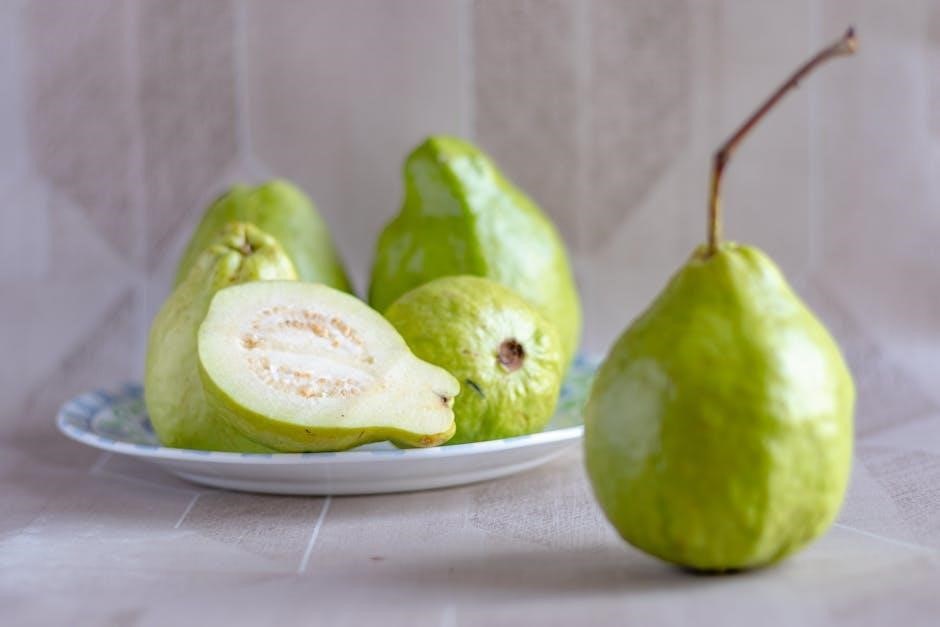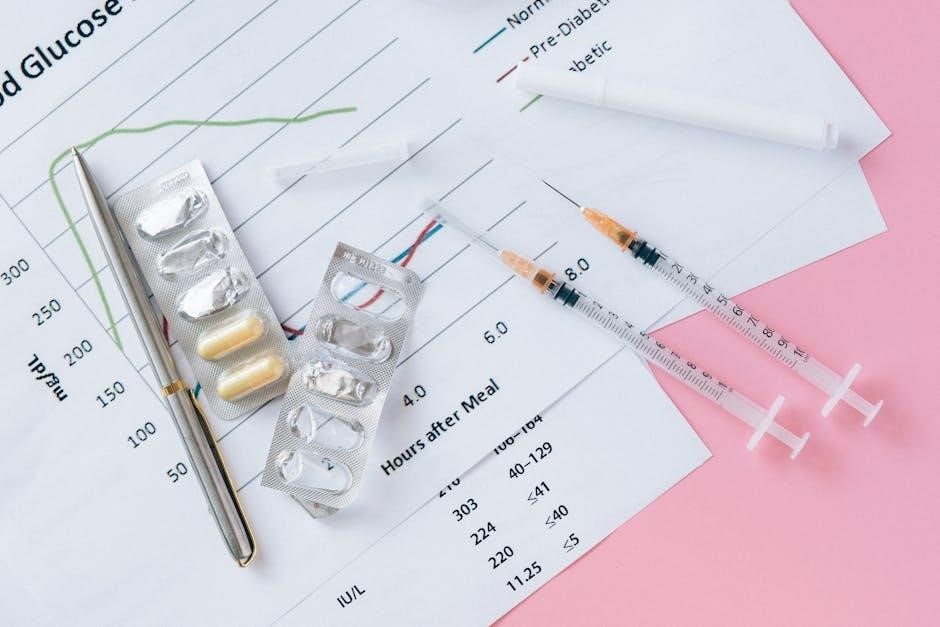alkaline diet food chart pdf
The alkaline diet focuses on balancing your body’s pH levels by consuming alkaline-rich foods․ It aims to reduce acidity‚ promoting overall health and wellness․ Key foods include vegetables‚ nuts‚ and seeds‚ while minimizing high-protein and processed foods․ A 70/30 ratio of alkaline to acidic foods is often recommended for optimal benefits․

1․1 What is the Alkaline Diet?
The alkaline diet is a dietary approach focused on balancing the body’s pH levels by emphasizing foods that promote alkalinity․ It suggests that consuming alkaline-rich foods‚ such as vegetables‚ nuts‚ and seeds‚ helps reduce acidity in the body․ The diet encourages a 70/30 ratio of alkaline to acidic foods to maintain optimal health․ By minimizing intake of high-protein‚ processed‚ and refined foods‚ individuals aim to support their body’s natural pH balance‚ potentially improving digestion‚ energy‚ and overall wellness․ This dietary plan is often supported by detailed charts and lists of alkaline and acidic foods for guidance․
1․2 Benefits of an Alkaline Diet
The alkaline diet offers several potential benefits‚ including improved digestion‚ enhanced energy levels‚ and support for overall health․ By focusing on alkaline-rich foods‚ individuals may reduce acidity‚ which can contribute to chronic conditions․ Key benefits include better nutrient absorption‚ reduced inflammation‚ and a stronger immune system․ Many followers report feeling more energized and experiencing fewer digestive issues․ The diet also encourages healthier eating habits‚ promoting a balanced lifestyle․ While individual results may vary‚ adhering to an alkaline diet can be a positive step toward long-term wellness and disease prevention․
1․3 Importance of pH Balance in the Body
Maintaining proper pH balance is crucial for overall health․ The body operates best when blood pH is slightly alkaline (7․35–7․45)․ A diet high in acidic foods can disrupt this balance‚ potentially leading to health issues․ The kidneys work to eliminate excess acids‚ but a prolonged acidic state can strain this system․ An alkaline diet helps reduce acidity‚ supporting the body’s natural pH equilibrium․ This balance is essential for energy production‚ enzyme function‚ and preventing chronic diseases․ By focusing on alkaline-rich foods‚ individuals can promote long-term health and well-being․
Understanding Alkaline and Acidic Foods
The alkaline diet categorizes foods based on their pH effects․ Alkaline foods like vegetables‚ nuts‚ and seeds help neutralize acidity‚ while acidic foods‚ such as meats and sugars‚ increase it․
2․1 Definition of Alkaline Foods
Alkaline foods are those that promote a balanced pH level in the body․ They are typically non-acidic and include vegetables‚ nuts‚ seeds‚ healthy oils‚ and certain fish․ These foods are rich in essential nutrients like vitamins‚ minerals‚ and antioxidants‚ which help neutralize acidity․ Examples include leafy greens‚ broccoli‚ spinach‚ and almonds․ By focusing on alkaline foods‚ individuals can support their body’s natural pH balance‚ potentially improving overall health and reducing the risk of chronic diseases․ Incorporating these foods into your diet is a key step in adopting an alkaline lifestyle․

2․2 Definition of Acidic Foods
Acidic foods are those that can increase acidity in the body‚ potentially disrupting pH balance․ They include high-protein items like meat‚ fish‚ eggs‚ and poultry‚ as well as refined carbohydrates‚ sugars‚ and processed foods․ These foods tend to be low in essential nutrients and high in substances that can cause inflammation․ While some acidic foods are necessary for a balanced diet‚ overconsumption can lead to health issues․ Moderation is key‚ as excessive acidity may strain the body’s systems and hinder optimal functioning․ Understanding which foods are acidic helps in making informed dietary choices․
2․3 The 70/30 Ratio: Balancing Alkaline and Acidic Foods
The 70/30 ratio is a guideline for balancing alkaline and acidic foods in the diet․ It suggests that 70% of daily intake should consist of alkaline foods‚ such as vegetables‚ nuts‚ and seeds‚ while 30% can be acidic foods like meats and grains․ This ratio helps maintain the body’s pH balance‚ supporting overall health․ By prioritizing alkaline-rich foods‚ individuals can reduce acidity and promote a more stable internal environment․ This balance is believed to enhance digestion‚ energy levels‚ and long-term wellness‚ making it a cornerstone of the alkaline diet approach․
Alkaline Food Chart Overview
The alkaline food chart categorizes foods by their pH potential‚ emphasizing vegetables‚ fruits‚ nuts‚ and healthy oils to promote balance and reduce acidity․
3․1 Vegetables: High-Alkaline Options
Leafy greens like spinach‚ kale‚ and watercress are top high-alkaline vegetables․ Broccoli‚ Brussels sprouts‚ beets‚ and asparagus also rank highly․ These veggies help maintain pH balance and support overall health․ Incorporate them into meals to boost alkalinity and reduce acidity․ Fermented vegetables‚ such as sauerkraut‚ are also excellent choices․ Aim for a variety of colors to ensure a broad range of nutrients․ These foods are essential for creating an alkaline-friendly diet and promoting wellness․ Use the alkaline food chart to guide your selections and maximize benefits․
3․2 Fruits: Alkaline and Acidic Choices
Citrus fruits like lemons and oranges are surprisingly alkaline‚ despite their acidic taste․ Tropical fruits such as mangoes‚ pineapples‚ and papayas also promote alkalinity․ Berries like strawberries and blueberries are mildly acidic but still nutritious․ Incorporate alkaline fruits into your diet to support pH balance․ Limit overly acidic fruits or pair them with alkaline options․ Refer to the alkaline food chart for specific ratings․ Balancing fruit choices helps maintain optimal alkalinity and overall health․ Fresh‚ whole fruits are ideal for maximizing benefits and minimizing acidity․
3․3 Proteins: Plant-Based and Lean Meats
Plant-based proteins like beans‚ lentils‚ tofu‚ and tempeh are excellent alkaline choices․ They are rich in nutrients and help maintain pH balance․ Lean meats‚ such as chicken and turkey‚ are less acidic than red meats and can be included in moderation․ Fish‚ especially oily varieties‚ can also be part of an alkaline diet․ Eggs are mildly acidic but can be balanced with alkaline foods․ Opt for organic‚ grass-fed‚ and wild-caught options to maximize benefits․ Refer to the alkaline food chart for specific protein ratings and incorporate these into your meals for a balanced diet․
3․4 Healthy Fats and Oils
Healthy fats and oils play a crucial role in the alkaline diet‚ providing essential nutrients and supporting overall health․ Olive oil‚ avocado oil‚ flaxseed oil‚ and coconut oil are highly alkaline and rich in antioxidants․ These fats help reduce inflammation‚ improve heart health‚ and aid in nutrient absorption․ Incorporate them into your meals for dressings‚ cooking‚ or as a finishing touch․ Moderation is key‚ as even healthy fats are calorie-dense․ Refer to the alkaline food chart for specific oil ratings and choose organic‚ cold-pressed options for maximum benefits․ Balancing these fats enhances your diet’s alkalinity and nutritional value․
3․5 Grains: Alkaline-Friendly Options
While many grains are acidic‚ certain options like quinoa‚ amaranth‚ and millet are more alkaline-friendly․ These grains are rich in minerals and fiber‚ supporting overall health․ Quinoa is a complete protein and a great base for meals․ Amaranth and millet are gluten-free and easy to digest․ Incorporate these grains into your diet by using them as sides or mixing them into salads․ Pairing them with alkaline vegetables enhances their benefits․ Refer to the alkaline food chart for specific grain ratings and choose whole‚ unprocessed options to maximize their alkalinity and nutritional value in your meals․
3․6 Dairy and Dairy Alternatives
Most dairy products‚ such as milk‚ cheese‚ and yogurt‚ are acidic and should be consumed in moderation․ However‚ some alternatives like almond milk‚ coconut milk‚ and cashew milk are alkaline-friendly․ These options are low in acidity and rich in nutrients‚ making them suitable for an alkaline diet․ When choosing dairy alternatives‚ opt for unsweetened and unflavored varieties to avoid added sugars․ Incorporating these into your meals can help maintain pH balance while providing essential vitamins and minerals․ Refer to the alkaline food chart for specific ratings and make informed choices to support your dietary goals․

Acidic Foods to Limit
Processed foods‚ high-protein meats‚ refined carbohydrates‚ and sugary items are highly acidic․ These can disrupt pH balance and should be minimized in an alkaline diet․
4․1 Processed Foods and Sugars
Processed foods and sugars are highly acidic and can disrupt the body’s pH balance․ They include items like packaged snacks‚ sugary drinks‚ and refined baked goods; These foods often lack essential nutrients and are high in empty calories‚ contributing to acidity․ Reducing their intake is crucial for maintaining an alkaline diet․ Instead‚ opt for whole‚ nutrient-rich foods to support overall health and wellness․ Limiting processed foods helps create a more balanced and alkaline-friendly diet․
4․2 High-Protein Foods (Meat‚ Fish‚ Eggs)
High-protein foods like meat‚ fish‚ and eggs are considered acidic and can lower the body’s pH levels․ While they provide essential nutrients‚ overconsumption may disrupt alkalinity․ Red meat‚ in particular‚ is highly acidic‚ while fish like salmon and eggs are slightly less so․ Moderation is key‚ as excessive intake can lead to an imbalanced pH․ Balancing these foods with alkaline-rich options helps maintain overall health․ Incorporating plant-based proteins‚ such as legumes or tofu‚ can reduce acidity and support a more alkaline diet․
4․3 Refined Carbohydrates
Refined carbohydrates‚ such as white bread‚ pasta‚ and pastries‚ are highly acidic and can disrupt the body’s pH balance․ These foods are stripped of nutrients and fiber‚ leading to rapid spikes in blood sugar and energy crashes․ Regular consumption of refined carbs can contribute to chronic acidity‚ potentially harming overall health․ The alkaline diet recommends limiting these foods to maintain optimal pH levels․ Instead‚ opt for whole‚ unprocessed grains and vegetables to support a more alkaline-friendly diet and improve digestion and energy stability․

Creating an Alkaline Diet Plan
Start by understanding the 70/30 ratio of alkaline to acidic foods․ Use an alkaline food chart to guide your choices‚ ensuring balance and gradual dietary changes for sustainability․
5․1 Sample Meal Plan for a Day
A balanced alkaline meal plan might include:
– Breakfast: Green smoothie with spinach‚ celery‚ and lemon‚ plus almonds․
– Lunch: Mixed greens salad with cucumber‚ bell peppers‚ avocado‚ and lemon-tahini dressing․
– Snack: Sliced veggies like carrots and zucchini with hummus․
– Dinner: Grilled fish (like salmon) with steamed broccoli and quinoa․
Stay hydrated with lemon water throughout the day․ This plan emphasizes alkaline-rich foods while maintaining variety and flavor‚ aligning with the 70/30 ratio for optimal pH balance․
5․2 Tips for Incorporating More Alkaline Foods
Start by gradually replacing acidic foods with alkaline options․ Use an alkaline food chart to guide your choices․ Incorporate leafy greens‚ citrus fruits‚ and nuts into meals․ Meal prep alkaline-rich salads or smoothies for convenience․ Substitute acidic grains with quinoa or brown rice․ Pair alkaline vegetables with lean proteins for balanced meals․ Stay hydrated with lemon water to support pH balance․ Experiment with alkaline-friendly recipes to keep your diet diverse and enjoyable․ Consistency is key to achieving long-term benefits from the alkaline diet․
Benefits of Following the Alkaline Diet

The alkaline diet promotes improved digestion‚ enhanced energy levels‚ and supports overall health by balancing your body’s pH levels and reducing acidity․
6․1 Improved Digestion
Adopting the alkaline diet can significantly enhance digestion by reducing acidity in the body․ Alkaline-rich foods‚ such as leafy greens and vegetables‚ help maintain a balanced gut environment․ This balance supports the proper absorption of nutrients and prevents digestive discomforts like bloating and indigestion․ A diet high in alkaline foods also promotes the growth of beneficial gut bacteria‚ further improving overall digestive health․ By minimizing acidic foods‚ individuals may experience fewer stomach issues and a more efficient digestive system․ This makes the alkaline diet a beneficial choice for those seeking to optimize their digestive well-being․

6․2 Enhanced Energy Levels
The alkaline diet is known to boost energy levels by reducing acidity in the body․ Alkaline-rich foods‚ such as leafy greens and healthy fats‚ provide essential nutrients that support energy production․ By minimizing acidic foods like processed meats and sugars‚ the body avoids energy drains caused by inflammation and poor digestion․ This dietary approach helps maintain stable blood sugar levels‚ preventing energy crashes․ Over time‚ followers of the alkaline diet often report increased vitality and reduced fatigue‚ making it easier to stay active and focused throughout the day․ This energy boost is a key benefit for those adopting the alkaline lifestyle․
6․3 Support for Overall Health and Wellness
The alkaline diet promotes overall health by reducing acidity and fostering a balanced internal environment․ It helps prevent chronic diseases linked to excess acid‚ such as osteoporosis and arthritis․ By focusing on nutrient-rich foods like vegetables‚ nuts‚ and healthy oils‚ the diet supports immune function and detoxification․ This approach also encourages better hydration and mineral absorption‚ which are crucial for maintaining vitality․ Many followers report improved skin health‚ reduced inflammation‚ and enhanced mental clarity․ By aligning with nature’s alkaline-rich foods‚ the diet offers a holistic path to long-term wellness and disease prevention‚ making it a popular choice for health-conscious individuals․

Common Misconceptions About the Alkaline Diet
Many believe the diet drastically changes blood pH‚ but it actually promotes balance․ The focus is on reducing acidity‚ not eliminating all acidic foods‚ emphasizing a healthy balance․
7․1 Debunking Myths About pH Levels
A common myth is that the alkaline diet significantly alters blood pH levels․ However‚ the body naturally regulates its pH balance‚ maintaining it around 7․35-7․45․ The diet doesn’t aim to drastically change blood pH but focuses on reducing acidity in tissues and fluids․ By consuming more alkaline foods‚ the goal is to offset the acidity from modern diets and lifestyle factors․ This balance supports overall health without extreme pH shifts․ The 70/30 ratio of alkaline to acidic foods helps achieve this equilibrium‚ promoting wellness without myths about extreme pH changes․
7․2 The Role of Supplements in the Alkaline Diet
While the alkaline diet emphasizes whole foods‚ supplements can support pH balance․ Alkaline minerals like calcium‚ magnesium‚ and potassium help neutralize acidity․ Greens powders and alkaline-forming supplements‚ such as wheatgrass or spirulina‚ are popular for boosting alkalinity․ Digestive enzymes and probiotics may also aid in nutrient absorption and gut health․ However‚ supplements should complement‚ not replace‚ a balanced diet․ It’s important to consult a healthcare provider before starting any supplementation to ensure safety and effectiveness․ Supplements can enhance the diet’s benefits but are not a substitute for a well-planned alkaline food chart․

Maintaining the Alkaline Diet Long-Term
Consistency is key to sustaining the alkaline diet․ Incorporate alkaline-rich foods daily and gradually reduce acidic options․ Regularly review and adjust your food chart to ensure variety and balance‚ keeping your body’s pH levels optimal for long-term health benefits․
8․1 Staying Motivated and Consistent
Staying motivated on the alkaline diet requires setting clear goals and tracking progress․ Celebrate small milestones‚ like incorporating more alkaline foods into meals․ Meal prepping and exploring new recipes can keep the diet exciting․ Surround yourself with a supportive community or find a diet buddy for encouragement․ Referencing an alkaline diet food chart PDF regularly can serve as a reminder of healthy choices․ Consistency is achieved by making gradual‚ sustainable changes rather than drastic overhauls․ Over time‚ the diet becomes a natural part of your lifestyle‚ promoting long-term health and wellness․
8․2 Incorporating Alkaline Foods into Your Lifestyle
Incorporating alkaline foods into your lifestyle involves making mindful choices and gradually shifting your eating habits․ Start by replacing acidic foods with alkaline alternatives‚ using a alkaline diet food chart PDF as a guide․ Meal prepping and planning can help maintain consistency․ Experiment with new recipes to keep your diet varied and enjoyable․ Focus on adding more vegetables‚ nuts‚ and healthy fats to your meals․ Over time‚ these changes will become second nature‚ fostering a healthier and more balanced lifestyle․ The key is to embrace progress‚ not perfection‚ and enjoy the journey toward better well-being․
Embracing the alkaline diet can lead to improved health and wellness․ By focusing on a 70/30 balance and using an alkaline diet food chart PDF as a guide‚ you can easily incorporate alkaline-rich foods into your daily meals‚ promoting a more balanced lifestyle and overall well-being․

9․1 Final Thoughts on the Alkaline Diet
The alkaline diet offers a practical approach to improving health by balancing your body’s pH levels․ By focusing on a 70/30 ratio of alkaline to acidic foods‚ you can enhance digestion‚ boost energy‚ and support overall wellness․ Incorporating foods like leafy greens‚ nuts‚ and healthy oils‚ while limiting processed and high-protein items‚ can make a significant difference․ Using an alkaline diet food chart PDF as a guide simplifies meal planning and ensures you stay on track․ Remember‚ consistency is key to experiencing the long-term benefits of this lifestyle․
9․2 Encouragement to Start Your Alkaline Journey
Embracing the alkaline diet is a powerful step toward better health․ Start by incorporating more alkaline-rich foods like vegetables‚ nuts‚ and seeds into your meals․ Use an alkaline diet food chart PDF as a handy guide to plan balanced meals․ Remember‚ small changes can lead to big results—aim for a 70/30 ratio of alkaline to acidic foods․ Don’t be too hard on yourself if you slip up; consistency is key․ Celebrate progress‚ and let the energy and vitality you gain motivate you to keep going․ Your body will thank you for this mindful‚ nourishing approach to eating․
